Note: These instructions are for Prof. Pitet’s M/W section only.
Assignment overview
20% of course grade
400-500 words
Due Friday, October 30th at midnight
Assignment instructions
For this assignment you will write a blog post that becomes part of Brooklyn College’s Open Education Resource (OER) for the Anthropology of Food course.
You will choose from among a list of topics listed on the course website. Your blog post will be a summary of one of the scholarly readings (not including films) listed under that topic. You must choose a different reading than the one you present on for class discussions. If you are interested in a topic but would like to summarize a reading not listed, please check with me.
Your summary should be approximately 400-500 words and should include the following:
- An introduction of the reading, including the title and the name of the author(s).
- A statement in your own words of the main argument(s).
- A brief description of the ethnographic examples or other evidence used to support the argument.
- A short discussion of the evidence: is it presented in a way that makes it clear how it is intended to support the author’s argument? Does it adequately do so?
- A short critical discussion of the text. For example: what does the author’s argument help us understand about how language works? Why might the author be making this argument? What about the argument is surprising, or how does it contradict what is traditionally thought about food? In other words, if we assume the author has a reason for writing the article other than their own gratification, what might that reason be?
- A properly formatted citation of the summarized text. (The syllabus and the course website both contain citations in acceptable formats.)
Your summary must be substantially in your own words. Use direct quotations sparingly, if at all, and only for technical definitions or brief passages that cannot be effectively paraphrased. If used, direct quotations should include a citation to the page number. See the second example below for what I mean by sparing direct quotations and page number citations.
Extra credit (1 point): when you introduce the reading in your blog post, hyperlink the text in your post to the PDF of the reading on the course website or to a copy of the reading that’s openly available on the Internet. For example: “In “Like an Extra Virgin,” Anne Meneley details the contradictions of olive oil as both a global commodity and a ‘traditional’ food…”
More extra credit (3 points): choose a reading from the list that’s not on the syllabus.
Super duper extra credit (pts depend on relevance and quality of the resource): include a relevant image, video, online article, or other resource in your post. The resource(s) you include should be pertinent to and thoughtfully integrated into your post. Don’t google your topic and insert the first image or video at the bottom of your post—find something truly relevant to your summary and useful to your readers, and indicate in the text of your summary how it’s relevant. (Make sure the resource you include is in the “public domain,” i.e., it’s not copyrighted or otherwise restricted. Youtube videos fit this description; images from Wikipedia will note whether they are in the public domain. For other sources, make sure you check first.)
For example: “Meneley discusses how discourses about olive oil are explicitly gendered, as well as the way olive oil, and ‘the Mediterranean’ more generally, stand in for an idealized site from which ‘real’ food is sourced. Yet through this very process, ‘the Mediterranean’ is figured as an ‘exotic’ yet homogenous place—one that can be ‘consumed as delicious and healthy food’ (684) while erasing any reference to the complex racial, religious, and geopolitical history and present of the region. After all, as Meneley points out, ‘part of the Mediterranean is Muslim’ (684), and—a point she does not underscore as explicitly—a significant part of the Mediterranean is African. Indeed, as Alia Yunis points out in the documentary Taste of the Golden Harvest, the production of ‘the Mediterranean,’ and in particular olive oil, involves not only gustatory pleasure and bodily health, morality, and spirituality, but also dispossession.”
Resources
Some resources for writing summaries and reading for the purpose of writing a summary.
- Critical reading tips
- Some strategies for reading academic articles
- An article on writing summaries
- More instructions on how to write a summary
- An example assignment for summaries—see the overview and purpose section
- And a very basic example of a summary to get you started
Creating a Commons account and posting your summary
- You will receive an invitation via email at your Brooklyn College (or other CUNY institution) address. Invitations can only be sent to cuny.edu addresses.

- Take note of the “claim key” (you may need it later).
- Most of you will probably not have an CUNY Commons account already. In that case, click the link at the bottom to register.
- This will take you to a Sign Up page. You’ll be required to choose a Username and password, fill in your Full Name, and to choose a College and a Role (use Undergraduate Student unless that’s not accurate). For Full Name, please use the name under which you’re enrolled at Brooklyn College.
- You can also upload a Profile Photo and fill in a Brief Descriptor if you’d like. You can update these later too.
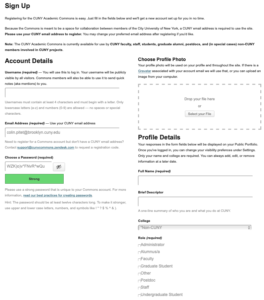
- Read the Terms of Service (lol), check the “I agree” box, and click the Complete Sign Up button.
- You’ll be taken to the main CUNY Commons page.

- Click the down arrow to the right of the icon in the top right corner. Go to My Invites, then Invitations Received.
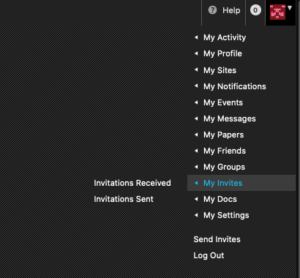
- You may see the invitation to the course site under Invitations Received. If so, click Accept.
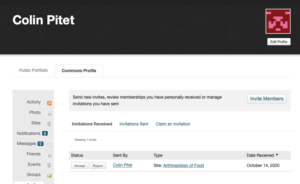
- If you don’t see the invitation here, click “Claim an invitation”.
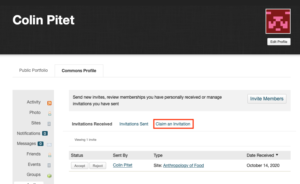
- Enter the Claim Key from the invitation email you received and click Submit. You may get a message saying “That invitation has already been accepted”. If so, proceed to the next step.
- Go back to the icon at the top right, choose My Sites, and click on the site for this course (i.e. Anthropology of Food or People and Language).

- You’ll be taken to your personal Dashboard for the site. Under the +New menu at the top, click Post.

- This is where you will create your blog post. You can write it in another document and paste the text into the editor, or you can write it directly in the editor.
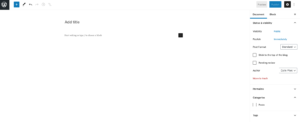
- For your post title, use this format: Summary of
“Article Title”byAuthor’s Full Name
At the end of your post, include a properly formatted citation of the reading you’re summarizing. (If you’re doing one that’s on the syllabus, look at the syllabus for a properly formatted citation. If you’re doing a different one, be sure to use Chicago style for the citation.)
So it should look something like this:

- When you’re done with the post and want to submit it, click Publish at the top right. It should ask you to double-check your settings. Under Tags, tag your post with “midterm”.
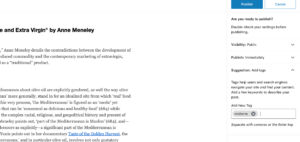
- Click Publish again to post your summary!

